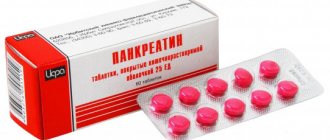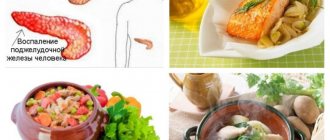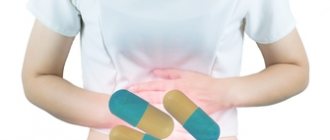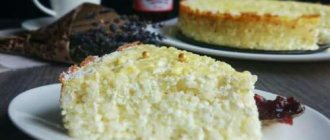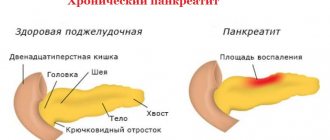The importance of the pancreas in the body is enormous. It promotes the production of enzymes that improve digestion and promote insulin production. Any malfunction of the pancreas negatively affects the functioning of the digestive tract and overall well-being. The most common disease of the pancreas is pancreatitis. The acute stage of the disease is accompanied by frustration, vomiting, pain in the hypochondrium, and the chronic course is aggravated by loss of strength, decreased appetite, and nausea. Let's try to figure out why you feel sick and how to cope with nausea?
Why does nausea and vomiting occur in acute pancreatitis?
The main cause of nausea with pancreatitis is a failure of enzyme synthesis processes, which causes food to be digested along with the mucous membranes of the stomach. Gagging and vomiting are a consequence of nausea and the throwing of stomach contents into the patient's esophagus.
Nausea occurs due to disturbances in the synthesis of enzymes
Nausea and vomiting during the disease may be present constantly or appear periodically. It depends on how severe the pancreatitis is. Pain and nausea may accompany every meal the patient eats.
The mechanism of nausea is as follows:
- The enzymes produced by the pancreas, instead of moving to the duodenum, remain in the gland.
- There is an accumulation of enzymes intended for digestion.
- Due to the lack of food, enzymes begin to digest the mucous membranes, provoking an inflammatory process.
- The process of breakdown and absorption of nutritional components is disrupted.
- Toxic substances are released.
The body's response to a large number of toxins is nausea, which can often result in vomiting. This mechanism is reminiscent of the body’s reaction to poisoning. However, in this case, nausea does not occur due to food poisoning, but due to the gastrointestinal tract, which is unable to assimilate the food consumed by a person.
When a person feels sick, this is one of the sure symptoms of pancreatitis. Its intensity directly depends on the severity of the disease. At the initial stage of the disease, this sensation may occur periodically or be permanent. The feeling of nausea is usually accompanied by pain. The opposite situation is also possible, when nausea appears after an attack of pain. It often ends in vomiting, but after it the person does not feel relief, as usually happens with poisoning.
The nature of vomiting in pathology
The formation of vomiting in any course of pancreatic disease always increases the intensity of pain in the epigastric area, is not accompanied by relief after its end and causes a lot of suffering to the patient. It can appear under the influence of many provoking factors.
The development of intense pain during a pancreatic attack is accompanied by a feeling of fear and anxiety, weakness, and often bleeding.
Pain can provoke the formation of collapse, as well as a state of shock, which in turn contribute to the development of a feeling of nausea and the formation of vomit.
When a pancreatic attack occurs, intoxication processes begin to activate in the patient’s body, during which exogenous and endogenous toxins begin to circulate in the blood plasma, causing the activation of vomiting centers in the medulla oblongata.
The presence of bile in the vomit is caused by the release of bile beyond the boundaries of the pylorus valve, which, when an attack of pancreatic disease occurs, comes into a relaxed state. Bile begins to enter the stomach cavity, and then into the intestines, mixing with all the contents, and is released when the gag reflex is activated.
According to statistics, approximately 60-70% of cases with acute, recurrent or exacerbated chronic pancreatic pathology occur against the background of acute and chronic forms of diseases affecting the biliary tract, such as cholecystitis, cholelithiasis, or obstructive jaundice. With the development of obstructive jaundice, a spasm forms in the area of the sphincter of Oddi, dyskinesia of the bile ducts develops, and they become blocked by the resulting calcifications. All this in combination is accompanied by the entry of bile into the cavity of the stomach and intestines and its presence in the vomit.
How to deal with the feeling of nausea with pancreatic disease
There are effective ways to relieve nausea due to pancreatitis and improve the patient’s well-being. If pancreatitis was diagnosed in a timely manner, treatment will significantly improve the condition of the organ and stop the progression of the disease. The unpleasant sensations will gradually decrease and will no longer bother the person.
It is necessary to remove unpleasant symptoms as soon as possible
Acute stage
After identifying pancreatitis, it is recommended to avoid eating processed foods, fatty, fried and overly seasoned foods. In the first days of the acute stage, experts recommend drinking water or rosehip decoction. Enough fluid must circulate in the body to avoid dehydration and speed up the release of toxins from the body.
It is necessary to stop eating processed foods and fatty, spicy foods.
You can reduce the frequency and duration of attacks by staying away from direct sunlight, maintaining a room temperature of 21°-22°C and regularly replenishing fluid reserves in the body.
Chronic course of the disease
Our body is designed very wisely. When one of the organs of the digestive system malfunctions, a kind of protective mechanism is activated and the patient’s appetite worsens. In this way, the body tries to protect itself from deterioration in health and attacks of nausea after eating. Under no circumstances should you go hungry if you have pancreatitis. To minimize the risk of deterioration in well-being after eating, you must adhere to the principles of dietary nutrition, eat small portions 4-5 times a day.
In case of chronic pancreatitis, the basic diet of a person should be:
- vegetable soups;
- porridge;
- lean meats, steamed or oven-cooked;
- dried fruits compote;
- natural, home-brewed berry jelly.
When the disease recedes and the patient’s well-being improves, many allow themselves to move away from the diet and add some favorite dishes and foods to the diet. If, due to such indulgences, an exacerbation of pancreatitis and deterioration of the condition occurs, it is necessary to immediately return to dietary nutrition.
Adjust your diet
Experts say that in case of diseases of the pancreas, nausea can be triggered by the consumption of prohibited foods such as alcohol, carbonated sweet drinks, tea, coffee, processed foods, chips, nuts and other foods harmful to the gastrointestinal tract.
How to cope with an attack of nausea before consulting a doctor
If discomfort or alarming symptoms appear, it is recommended to seek help from a specialist. However, this is not always convenient or possible. A person’s well-being may worsen during a business trip or on vacation, when there is absolutely no time to visit a doctor. In such cases, you can try to calm the unpleasant symptoms as follows:
- when the patient begins to feel sick, he should lie down;
- apply ice or a bottle of cold water to the area on the left side under the ribs;
- Squeeze lemon juice into drinking water to reduce the feeling of faintness;
- When a gag reflex appears, you should not try to hold back vomiting. This will only increase the urge to vomit and worsen the person’s well-being;
- take medications that are designed to block nausea and prevent vomiting.
Use medications to relieve nausea and vomiting
The listed methods are recommended to be used only if a person knows about the problems he has with the pancreas and the ailments he experiences are mild. Otherwise, you should seek medical help as soon as possible, as nausea and vomiting may indicate serious illnesses that are dangerous to human health.
Causes of nausea
In most cases, the development of nausea in chronic pancreatitis begins after eating. Some foods are absorbed well, but there are certain foods that can increase the intensity of cramps. The pancreatic ducts begin to narrow more strongly, resulting in the return of enzymes intended for processing food in the intestinal cavity to the pancreatic cavity, where the processes of self-digestion of the organ are activated.
Among the provoking factors, the most dangerous are:
- dishes cooked in a frying pan,
- spicy foods and enriched with fiber,
- coffee and carbonated drinks,
- alcohol.
Consumption of the above foods leads to serious disturbances in the functioning of the pancreas. Nausea or vomiting occurs depending on the amount eaten and the severity of the food.
Causes of nausea with pancreatitis?
In order to understand why nausea occurs during inflammatory processes of the pancreas, you need to understand the etiology of the disease.
The pancreas is a specific organ in the abdominal cavity that is responsible for producing insulin and producing pancreatic enzymes for digestion. The gland is connected by ducts to the duodenum. Through the ducts, enzymes enter the food that a person has taken and begin to digest it and break it down into proteins, carbohydrates and fats.
If there are deviations in the functioning of the glandular pancreatic tissue, enzymes may partially or completely not enter the duodenum, finding no way out, they accumulate in the organ that produced them. This condition is accompanied by acute abdominal pain that does not go away on its own.
But in addition to pain, the patient is also bothered by nausea. This is due to the fact that the digestive tract, without the help of enzymes, cannot fully process food and is preparing to return to the outside the food that the patient has eaten.
Nausea is often replaced by vomiting with pancreatitis, and this indicates that enzymes do not enter the gastrointestinal tract at all.
How to get rid of the feeling of nausea
If the patient is haunted by fears that vomiting in acute pancreatitis is a constant phenomenon, it is logical to think about how to protect yourself from unpleasant sensations.
Precautionary measures
How to prevent nausea with pancreatitis:
- follow a diet and diet (eat at strictly prescribed times, to the extent prescribed by medical prescriptions);
- monitor the room temperature: the patient should not overheat or become hypothermic, avoiding unpleasant sensations and phenomena.
Diet and nutrition are extremely important. In case of acute pancreatitis, so that vomiting does not bother you, it is advisable not to eat or drink anything other than mineral water or rosehip decoction. The recommendation will eliminate the risk of dehydration and prevent possible attacks of nausea.
After the first days of an exacerbation, introduce easily digestible foods into your diet:
- vegetarian soups (excluding vegetables prohibited for pancreatitis);
- porridge with water (add a small dose of oil for taste, if desired);
- lean meat/fish;
- cottage cheese;
- jelly (with low juice concentration);
- puddings.
It will be necessary to exclude foods that strain the gastrointestinal tract.
Sometimes the body protects itself from excessive food intake and puts a psychological block on it, reducing appetite. The patient is able to listen to the block placed or, conversely, begins to overcome this condition. Staying for 2-3 days without food or trying to awaken your appetite with tasty dishes does not help: the described techniques do not bring relief to the intestines.
Despite the protests of the digestive system, it is required to adhere to the therapeutic diet prescribed by the attending physician. The body must receive energy to function, or the person’s condition will deteriorate sharply.
If, in such an uncomfortable state, the patient feels the need to smoke a cigarette or take a dose of alcohol, it is better to drive annoying thoughts away. Nicotine and alcohol cause the same negative reaction in the body and will lead to consequences much more unpleasant than vomiting due to pancreatitis.
If the patient is in remission and experiencing nausea, there is a reason to temporarily return to a strict diet.
Recommended Diet
The diet involves strictly limiting fatty foods from carbohydrates. It is not recommended to eat foods that contribute to gas formation in the intestines. And also those that produce gastric juice and contain coarse fiber.
It is recommended to eat steamed, boiled and baked foods. You can also drink tea with lemon, fruit and berry juices diluted with water. Unsweetened cookies, slightly dried white bread. You can’t eat sugar, you can eat low-fat cottage cheese and fermented milk products.
It is prohibited to consume carbonated drinks, cocoa, coffee, grape juice. Fresh bread, any kind of pastries, meat, milk soups, borscht, bean porridge, barley and corn porridge, lard and spices.
Only lean meat is allowed: veal, beef, turkey, chicken, boiled lean fish. Vegetable soups with cereals, porridges and compotes. You cannot eat eggs, sausages, or various smoked foods. You also need to give up any type of confectionery, ice cream, alcoholic beverages, and various fats.
https://youtube.com/watch?v=a_KituZddT0
It should be recalled that traditional methods of combating nausea with pancreatitis cannot replace drug therapy. They are only auxiliary means.
In addition, experts emphasize: nausea cannot be treated - it can only be temporarily stopped, no matter what drugs are in question. To get rid of a symptom forever, it is necessary to eliminate the cause - that is, pancreatitis. And this is almost impossible without the help of doctors.
Diseases of the pancreas, including pancreatitis, do not go away without leaving a mark on the functioning of the digestive system. Symptoms manifest themselves in different ways: during acute attacks of the disease, the patient constantly has a feeling of nausea and periodic diarrhea. Patients with chronic pancreatitis sometimes experience pain in the sides. You cannot do without a slight feeling of nausea, which reduces your appetite.
Nausea with pancreatitis is a constant phenomenon, as 95% of patients complain. Let's consider why the condition arises and how to deal with the manifestation.

